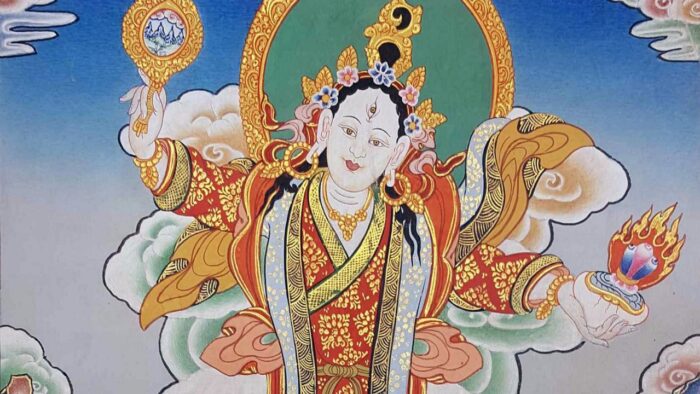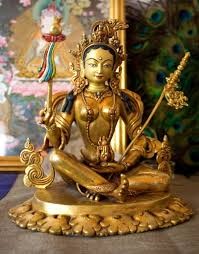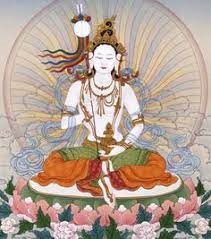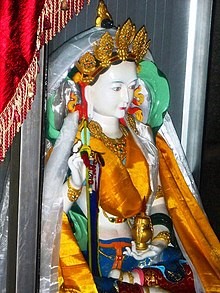Mandarava was the eighth century consort of the great Padmasambhava (the great Tibetan tantric master). She was a wise, beautiful and meritorious princess. Dakini Mandarava was an incarnation of the female Buddha Pandaravasini, the consort of Amitabha. Mandarava is considered to be a female guru-deity in Tantric Buddhism or Vajrayana. She was born to a royal couple in Zahore, Bengal[1] but other scholars believe that she was born in the modern city of Mandi in Himachal Pradesh[2]. Mandi is supposedly named after Mandarava. Her birth was apparently with many extraordinary signs. There are some scholars who believe that she was born in Uddiyana or Swat Valley of northern Pakistan. She is known as being Guru Rinpoche’s or Padmasambhava’s disciple and was highly educated at a very young age. According to legend she renounced her royal birthright at an early age in order to practice the dharma. She dedicated herself in many virtuous works.
(Figure 1: Mandarava or Machik Drubpai Gyalmo)
Her birth was accompanied by many extraordinary signs. Mandarava dedicated herself in various sectors of her academic life. She mastered many skills from childhood. She studied literature, medicine, poetics, logic, grammar, chanting and astrology. By the time she was thirteen years of age, she became the greatest scholar. She also studied the great sutras. Once she was mesmerised by an unusually intelligent girl, Palmo Shonu[3] who was sixteen years old and had a divine lineage and her father’s name is Rigehe Delwa and mother Lhamo Yukye. A master in scriptures and astrology she had debated with a monk once and defeated him. Seeing the talented Palmo Shonu Mandarava requested by her mother to appoint her as her teacher to which her mother readily agreed. Consequently Palmo Shonu took vows of ordination and remained close to Mandarava. Together they both mastered inner and outer teachings of five sciences. She also studied arts, crafts and sorcery. She acquired excellence in every science that existed in India at that time. She became a scholar without rival. Mandarava taught the people around her three baskets of scripture. Now on the path of dharma, they gradually erected a temple[4].
Mandarava had made her intentions of renunciation extremely clear, but the king still tried to suppress her. He ordered the servants not to let her venture outside the palace walls. Once in the moment of utter despair and misery she broke down, and Buddha Vajrasattva suddenly appeared in the space before her. Disgusted by Saṃsāra, Mandarava escaped her forced marriage and received monastic ordination from a bodhisattva. Fearless and strong-minded she and her five hundred nun attendants then lived in their heavily guarded palace. Her father was worried about the contamination of royal blood line and what he perceived as Mandarava’s unfaithfulness. He endeavoured to have both Mandarava and Padmasambhava purified by immolation through the flames of pyre. Instead of finding their corpses incensed and charred, Vihardhara found that the fire of the pyre has been transformed into Lake Riwalsar[5] located on a mountain in the Mandi district, India. This lake is shaped like a square with shoreline of about 735 m at a distance of about 185 km southeast of Mount Everest. There arose a lotus flower supporting the unharmed Mandarava and Padmasambhava. In this way, they achieved their secret name of Vajravarahi and Hayagriva respectively. It is held as a sacred spot for Hindus, Sikhs and Buddhists. There are three Buddhist monasteries at Riwalsar. The lake also has three Hindu temples dedicated to Lord Krishna and Lord Shiva. It is associated with the escape of the Pandavas from the burning place of wax, an episode from the epic Mahabharata. It was from here that the great Indian teacher and Tantric guru Padmasambhava left for Tibet. He is known to the Tibetans as Guru Rinpoche. It was under Padmasambhava’s influence that Mahayana spread over Tibet.
(Figure 2: Credit: Pinterest – Mandarava or Wisdom Dakini)
Mandarava accompanied Padmasambhava to Maratika cave where they perfected longevity practices pertaining to the union of Hyagriva[6] and Vajravārahī[7]. They achieved eternal life which refers here to the unchanging realization of the ultimate nature of mind and phenomena. On return from Maratika, they subjugated heretics in the kingdom of Kosala. Mandarava withstood being raped and beaten by wrathful demons in the Yongdutsel charnel ground. In fact she manifests herself as a wrathful Dakini and managed to tame the cannibals in the land of camara and brought them on the path of dharma. She displayed miracles in eight other charnel grounds subduing the barbarous beings and convincing them to follow the righteous path. After meditating for three months in Maratika cave, they both received a clear vision of the Buddha and achieved a state of immortal pure awareness. They both became free from the cycle of birth, old age, sickness, death. They gained the ability to transcend the ordinary elements with powers that included altering solid matter, rainbow light displays, and so forth. The terma (various forms of hidden teachings that are key to Vajrayana) constituted the teachings of Buddha Amitabha and they were elementally encoded as terma at the request of bodhisattva Avolokitesvara. While Padmasambhava continued to spread the teachings throughout the Himalayan region, Mandarava remained in India. Together they both practiced and accomplished the chime soktik, a terma received directly from Buddha Amitayus, in Nepal. Through the practice of diligence, Mandarava realised a degree of spiritual mastery equal to that of Padmasambhava, evidenced in her honorific name Machig Drupa Gyalmo ‘singular queen mother of attainment’. She displayed miracles in eight other charnel grounds for taming the wrathful beings in each and converting them to follow the path of dharma.[8] She is venerated as a goddess in Tibet. She was keen to establish and spread guru Padmasambhava’s Vajrayana tradition.
(Figure 3: Mata Kuan Rani in Mandi, Himachal Pradesh)
Mandarava at the age of sixteen became the first of Padmasambhava’s five historical spiritual consorts in Maratika cave. Mandarava is said to have manifested her Sambhogakaya form at the great Dharma wheel of Tamdruk where she engaged in a dialogue of mantra and mudrā with Padmasambhava. Mandarava is usually represented in a standing pose and in energetic dance with her right leg raised that displays her enlightened activity and dakini nature. She ordained by the famous Santarakṣita[9]. She is the yogini form of a female with a fierce spirit – erotic, ecstatic, profound, wise and peaceful. Her nature is beyond the grasp of the conceptual mind.
Mandarava is also known as ‘Mata Kuan Rani or Princess of the Well’ temple in Mandi, Himachal Pradesh, India. There is a slate-roofed temple over a deep well nowdays. It is a holy shrine for both Hindus and Buddhists and it still worshiped to this day. Mother Mandarava guides devotees to her future place of rebirth in this realm of great bliss. In the land of Kosala, she tamed the beings through miraculous power. She manifested herself as two Utpal flowers of white and red, one in Tibet and one in Nepal. She transformed into the embodiment of the supreme consort, the secret primordial wisdom dakini. Dakini refers to a woman who dances in space or woman who revels in the freedom of emptiness. Dakini is a Khandro word in Tibetan which means sky dancer or sky dweller. They are not ladies who leave a heavily beaten path. At times, their trail disappears into the air where they take flight and embark upon their enlightenment adventures. The most sacred aspect of the feminine principle is found in Tibetan Buddhism, embodying both the humanity and divinity of the female form. The accounts of Mandarava’s life illuminate the experiences of a great and wise dakini who inspired everyone she met, turning their minds irrevocably toward liberation. The female Buddha Mandarava or Pandaravasini, and her emanations recounted her magisterial perspective in the world. She is finally victorious in this struggle.
The iconography of Mandarava is depicted in a standing pose but there are some of the images of her in seating position or meditative postures. But she is represented in an energetic dance occasionally with her right leg raised, denoting her enlightened activity and dakini nature. She holds a dadar or arrow in her right hand and a ritual skull cup. She however, is already liberated from the cycle of suffering and is perfectly omniscient.
The purpose of this depiction is not to show us that only those of high status or wealth are fortunate enough to have such opportunities, but to reveal that Mandarava was able and willing to renounce that which is most difficult to renounce, namely attachment to the worldly life. She abandoned all her temporary pleasures that steal away precious opportunities for spiritual development. She intentionally emanated into realms of ordinary existence in order to inspire beings and lead them through this gradual process, teaching them how to progress in the spiritual path through her example. Presently she is an inspiration and who set the novel feminist trend with hundreds of bold and independent female tantric practitioners. She converted herself into the perfected dakini or maha dakini. She is bodhisattva. The idea that Vajrayana Buddhism is male-oriented is misleading. Mandarava was indeed a personification of feminine liberation.
[1] Lama Chonam and Sangey Khandro, trans. The Lives and liberartion of Princess Mandarava: The Indian Student and teacher of Padmasambhava, p.78-116.
[2] Heena Thakur, Dr. Konchok Tashi, Guru Padmasambhava and his five main Consorts, p.82.
[3] Lama Chonam and Sangey Khandro trans. The Lives and liberartion of Princess Mandarava: The Indian Student and teacher of Padmasambhava, p.128.
[4] Ibid.
[5]Dowman, Keith. Sky Dancer: The Secret Life and Songs of the Lady Yeshe Tsogyel, p. 265.
[6] Gyalwa Chang Chub and Namkha Nyingpo, Lady of The Lotus-Born The Life and Enlightenment of Yeshe Tsogyal, p.4.
[7] Ibid.
[8]https://mandalas.life/2019/long-life-dakini-mandarava.
[9] Gyalwa Chang Chub and Namkha Nyingpo
, Lady of The Lotus-Born The Life and Enlightenment of Yeshe Tsogyal, p.
Disclaimer: The opinions expressed in this article belong to the author. Indic Today is neither responsible nor liable for the accuracy, completeness, suitability, or validity of any information in the article.










